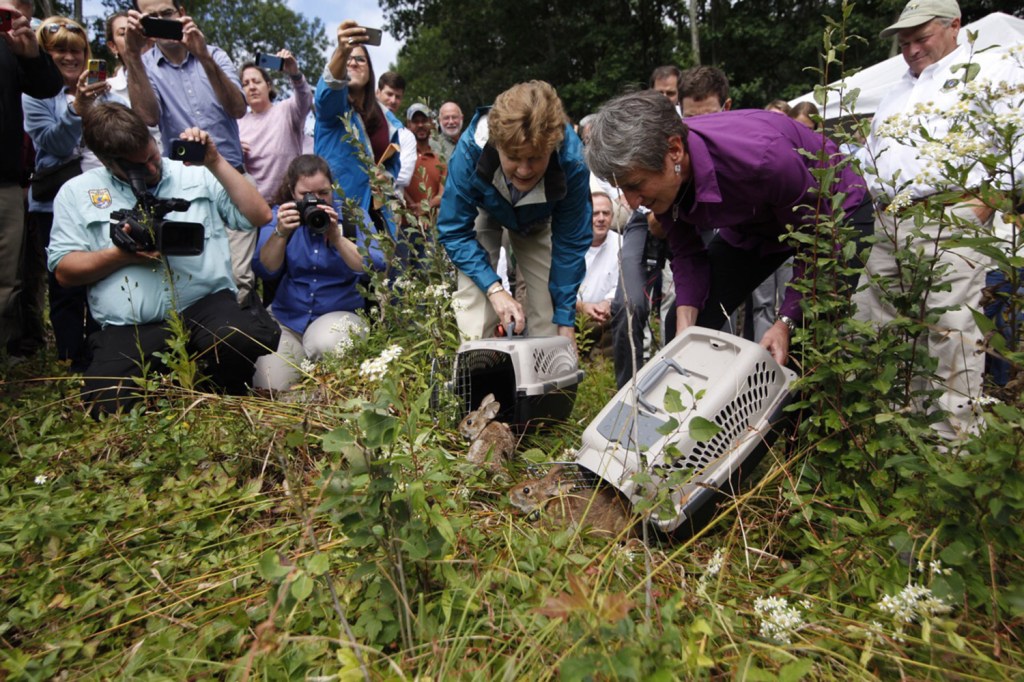DOVER, N.H. — The bunnies, finally free, didn’t seem to know what to do.
Maybe it was the cameras or the crowds of people, but instead of making a break for it, they took a few steps from their cages and started to nibble on some grass near the edge of the thicket several hundred feet behind the farmhouse owned by Rick and Donna Ambrose.
This was the new home for a pair of New England cottontails, bred and raised in captivity, that are members of a species of rabbit threatened by extinction nearly a decade ago.
Friday’s release of the two furry creatures was part of an ongoing multi-agency, multi-state effort to save the cottontail that brought a member of President Barack Obama’s Cabinet and other wildlife and conservation officials to Dover, just across the Maine line.
“This isn’t really about a bunny,” said U.S. Interior Secretary Sally Jewell, who had the honor of releasing one of the bunnies. “This is about an epic collaboration … that saved an entire species from being wiped off the face of the earth.”
The New England cottontail, the only native rabbit species east of the Hudson River and the inspiration for Massachusetts author Thornton Burgess’s “The Adventures of Peter Cottontail,” has lost about 80 percent of its habitat over the last half century, mostly to development. The species needs dense bushes and thickets to help shield it from predators.
The land behind the Ambrose’s farm is perfect and the bunnies have been raised in a fenced-in, outdoor area with similar characteristics, so they should have no trouble adapting to the wild.
But there are no guarantees. The hope is that the two bunnies reproduce like, well, bunnies and quickly rebuild the population.
By year’s end, about 40 New England cottontails bred in captivity will be reintroduced to their native habitat, which also includes much of southern Maine. The broader goal is to increase the population to 13,500 cottontails by 2030.
Federal and state wildlife officials and private landowners have been working since 2008 on a large-scale effort to protect the rabbit and conserve forest habitat in Maine and five other states in the Northeast.
Voluntary restoration efforts on private lands have played a vital role. In the last three years, the U.S. Department of Agriculture’s Natural Resources Conservation Service has worked with owners and managers of private lands to restore more than 4,400 acres of habitat by removing trees and invasive species, planting native shrubs and creating brush piles. Roughly 1,000 of those acres are in Maine, including a large swath owned by three Scarborough landowners, Camp Ketcha, the Scarborough Land Trust and the MacDonald Family. There also is a large cottontail population in Cape Elizabeth, on land near Ram Island Farm.
These restoration efforts also have created and improved young forest habitat that is relied upon by at least 65 other species, including bobcats, snowshoe hares, songbirds and box turtles.
U.S. Sen. Jeanne Shaheen of New Hampshire said at Friday’s event that although we “live in a time when biodiversity is in rapid decline,” that declined can be reversed.
“The larger lesson to draw is that we are not helpless,” she said.
Development is the primary culprit in the cottontail’s decline as humans change the early-successional forests – young forests featuring dense thickets and shrubby vegetation – the rabbits need to survive. Invasive plants also played a role by out-competing the native food source for the cottontail, as did the introduction of the much more common Eastern cottontail which is more adaptable to living in a variety of habitats and is better able to escape predators when in the open.
The New England and Eastern cottontails look so much alike that the two are often difficult to tell apart. Mainers also sometimes confuse cottontails with snowshoe hares.
The New England cottontail is already designated as an endangered species in Maine under state law.
Since 2006, the federal agency has been examining whether to add the species to the federal Endangered Species List, a designation that would protect the species from being harmed or killed and can trigger additional layers of bureaucratic review for projects that involve federal agencies or federal money.
Faced with declining numbers, federal officials were tasked with deciding whether to list the cottontail under the Endangered Species Act or to demonstrate that collaborative restoration programs showed promise.
“This initiative is a model for combining science, resources and public-private collaboration to advance the conservation of a species previously destined for federal protection,” U.S. Fish and Wildlife Service Director Dan Ashe said Friday. “This is a moment for us all to feel proud – proud of the partnerships we forged among state and federal governments, landowners, conservation organizations, tribes and businesses; and proud of the successes those efforts brought.”
Send questions/comments to the editors.




Success. Please wait for the page to reload. If the page does not reload within 5 seconds, please refresh the page.
Enter your email and password to access comments.
Hi, to comment on stories you must . This profile is in addition to your subscription and website login.
Already have a commenting profile? .
Invalid username/password.
Please check your email to confirm and complete your registration.
Only subscribers are eligible to post comments. Please subscribe or login first for digital access. Here’s why.
Use the form below to reset your password. When you've submitted your account email, we will send an email with a reset code.